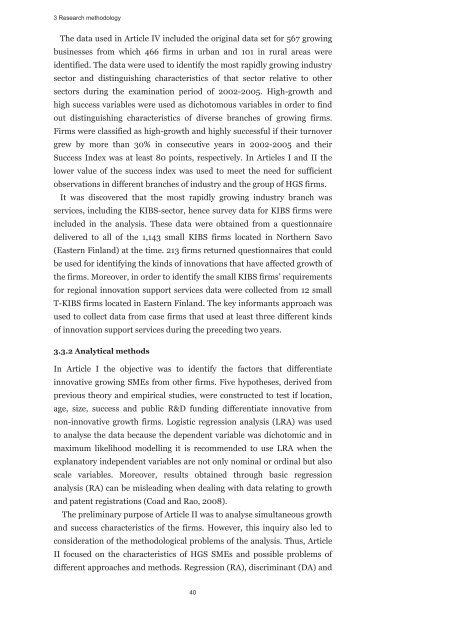dissertation in pdf-format - Aalto-yliopisto
dissertation in pdf-format - Aalto-yliopisto
dissertation in pdf-format - Aalto-yliopisto
You also want an ePaper? Increase the reach of your titles
YUMPU automatically turns print PDFs into web optimized ePapers that Google loves.
3 Research methodology<br />
The data used <strong>in</strong> Article IV <strong>in</strong>cluded the orig<strong>in</strong>al data set for 567 grow<strong>in</strong>g<br />
bus<strong>in</strong>esses from which 466 firms <strong>in</strong> urban and 101 <strong>in</strong> rural areas were<br />
identified. The data were used to identify the most rapidly grow<strong>in</strong>g <strong>in</strong>dustry<br />
sector and dist<strong>in</strong>guish<strong>in</strong>g characteristics of that sector relative to other<br />
sectors dur<strong>in</strong>g the exam<strong>in</strong>ation period of 2002-2005. High-growth and<br />
high success variables were used as dichotomous variables <strong>in</strong> order to f<strong>in</strong>d<br />
out dist<strong>in</strong>guish<strong>in</strong>g characteristics of diverse branches of grow<strong>in</strong>g firms.<br />
Firms were classified as high-growth and highly successful if their turnover<br />
grew by more than 30% <strong>in</strong> consecutive years <strong>in</strong> 2002-2005 and their<br />
Success Index was at least 80 po<strong>in</strong>ts, respectively. In Articles I and II the<br />
lower value of the success <strong>in</strong>dex was used to meet the need for sufficient<br />
observations <strong>in</strong> different branches of <strong>in</strong>dustry and the group of HGS firms.<br />
It was discovered that the most rapidly grow<strong>in</strong>g <strong>in</strong>dustry branch was<br />
services, <strong>in</strong>clud<strong>in</strong>g the KIBS-sector, hence survey data for KIBS firms were<br />
<strong>in</strong>cluded <strong>in</strong> the analysis. These data were obta<strong>in</strong>ed from a questionnaire<br />
delivered to all of the 1,143 small KIBS firms located <strong>in</strong> Northern Savo<br />
(Eastern F<strong>in</strong>land) at the time. 213 firms returned questionnaires that could<br />
be used for identify<strong>in</strong>g the k<strong>in</strong>ds of <strong>in</strong>novations that have affected growth of<br />
the firms. Moreover, <strong>in</strong> order to identify the small KIBS firms’ requirements<br />
for regional <strong>in</strong>novation support services data were collected from 12 small<br />
T-KIBS firms located <strong>in</strong> Eastern F<strong>in</strong>land. The key <strong>in</strong>formants approach was<br />
used to collect data from case firms that used at least three different k<strong>in</strong>ds<br />
of <strong>in</strong>novation support services dur<strong>in</strong>g the preced<strong>in</strong>g two years.<br />
3.3.2 Analytical methods<br />
In Article I the objective was to identify the factors that differentiate<br />
<strong>in</strong>novative grow<strong>in</strong>g SMEs from other firms. Five hypotheses, derived from<br />
previous theory and empirical studies, were constructed to test if location,<br />
age, size, success and public R&D fund<strong>in</strong>g differentiate <strong>in</strong>novative from<br />
non-<strong>in</strong>novative growth firms. Logistic regression analysis (LRA) was used<br />
to analyse the data because the dependent variable was dichotomic and <strong>in</strong><br />
maximum likelihood modell<strong>in</strong>g it is recommended to use LRA when the<br />
explanatory <strong>in</strong>dependent variables are not only nom<strong>in</strong>al or ord<strong>in</strong>al but also<br />
scale variables. Moreover, results obta<strong>in</strong>ed through basic regression<br />
analysis (RA) can be mislead<strong>in</strong>g when deal<strong>in</strong>g with data relat<strong>in</strong>g to growth<br />
and patent registrations (Coad and Rao, 2008).<br />
The prelim<strong>in</strong>ary purpose of Article II was to analyse simultaneous growth<br />
and success characteristics of the firms. However, this <strong>in</strong>quiry also led to<br />
consideration of the methodological problems of the analysis. Thus, Article<br />
II focused on the characteristics of HGS SMEs and possible problems of<br />
different approaches and methods. Regression (RA), discrim<strong>in</strong>ant (DA) and<br />
40
















